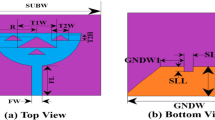Abstract
A performance study on the design and analysis of an extended Sierpinski gasket fractal antenna for mm-wave femtocell applications were implemented. The initial analysis includes the design of different stages of basic Sierpinski gasket fractal antenna and its performance characteristics like reflection coefficient, gain, and efficiency. The size of the basic equilateral triangle patch is around 5.193 mm. The antenna is designed on Arlon Di-clad 880 mm substrate materials with a thickness of 0.508 mm and a dielectric constant of 2.2. The proposed antenna efficiently operates at frequencies from 24 to 61 GHz with reflection coefficient values \(-10\) to \(-32\) dB. The simulated gains in dB values at resonant frequencies are from 02 to 16 dB with almost 100% radiation efficiency. Later on, this design was extended, simulated, fabricated, and results like reflection coefficient, VSWR, and radiation are measured in an Anechoic chamber. The designed extended Sierpinski fractal antenna was radiated with the maximum electric field in all directions indicating an omnidirectional antenna at the desired feed position. The proposed antenna can work with 5G femtocell applications where Femto base stations require miniaturized antennas for indoor communications.


















































Similar content being viewed by others
References
Chandrasekhar, V., Andrews, J., & Gatherer, A. (2008). Femtocell networks: a survey. arXiv:0803.0952.
Rappaport, T. S., Sun, S., Mayzus, R., Zhao, H., Azar, Y., Wang, K., & Gutierrez, E. (2013). Millimeter wave mobile communications for 5G cellular: It will work! IEEE Access, 1, 335–349.
Abu-Rgheff, M. A. (2019). 5G physical layer technologies. Hoboken: Wiley.
Telecom Regulatory Authority of India (TRAI). (2019). Enabling 5G in India, a White Paper.
Harini, V., Sairam, M. V. S., Madhu, R., Naresh Kumar, M. (2019). Crescent shaped slot mmwave array antenna for future 5G femtocells applications. International Journal of Engineering and Advanced Technology (IJEAT), 8(5).
Şeker, C., Ozturk, T., & Güneşer, M. T. (2018). A single band antenna design for future millimeter wave wireless communication at 38 GHz. European Journal of Engineering and Formal Sciences, 2(2), 35–39.
Imran, D., Farooqi, M. M., Khattak, M. I., Ullah, Z., Khan, M. I., Khattak, M. A., & Dar, H. (2018). Millimeter wave microstrip patch antenna for 5G mobile communication. In 2018 International Conference on Engineering and Emerging Technologies (ICEET) (pp. 1–6). IEEE.
El Mashade, M. B., & Hegazy, E. A. (2018). Design and analysis of 28 GHz rectangular microstrip patch array antenna. WSEAS Transactions on Communications, 17, 1–9.
Muhammad, S., Yaro, A. S., Ya’u, I., & Abubakar, A. S. (2019). Design of single feed dual-band millimeter wave antenna for future 5G wireless applications. Science World Journal, 14(1), 84–87.
Mishra, G. P., Maharana, M. S. , Modak, S., & Mangaraj, B. B. (2017). Study of Sierpinski fractal antenna and its array with different patch geometries for short wave ka band wireless applications. In 7th International Conference on Advances in Computing & Communications, ICACC-2017, 22–24 August 2017, Cochin, India.
Kang, S., & Jung, C. W. (2015). Dual band and beam-steering antennas using reconfigurable feed on Sierpinski structure. International Journal of Antennas and Propagation, 2015, 492710.
Gupta, M., & Mathur, V. (2017). Sierpinski fractal antenna for internet of things applications. Materials Today: Proceedings, 4(9), 10298–10303.
Werner, D. H., & Ganguly, S. (2003). An overview of fractal antenna engineering research. IEEE Antennas and propagation Magazine, 45(1), 38–57.
Vinoy, K. J. (2002). Fractal shaped antenna elements for wide-and multi-band wireless applications. Ph.D. Thesis. The Pennsylvania State University. The Graduate School. College of Engineering.
Rogers Corporation. (1998).PTFE/Woven Fiberglass Laminates, Diclad series datasheet, Printed in U.S.A Arlon Materials for Electronics, 1200-R4 .
Pasternack Enterprises. (2016).1.85mm female field replaceable connector 2 Hole Flange Mount 0.009 inch Pin,0.481 inch Hole spacing , Data sheet PE44337.
Darimireddy, N. K., Reddy, R. R., & Prasad, A. M. (2018). A miniaturized hexagonal-triangular fractal antenna for wide-band applications [Antenna Applications Corner]. IEEE Antennas and Propagation Magazine, 60(2), 104–110.
Azari, A. (2011). A new super wideband fractal microstrip antenna. IEEE Transactions on Antennas and Propagation, 59(5), 1724–1727.
Ali Dorostkar, M., Islam, M. T., & Azim, R. (2013). Design of a novel super wideband circular-hexagonal fractal antenna. Progress in Electromagnetics Research, 139, 229–245.
Mukti, P. H., Wibowo, S. H., & Setijadi, E. (2016). A compact wideband fractal-based planar antenna with meandered transmission line for L-band applications. Progress In Electromagnetics Research, 61, 139–147.
Harini, V., Sairam, M. V. S., & Madhu, R. (2020). Design of 31.2/40.1667 GHz dual band antenna for future mmwave 5G femtocell access point applications. In Advances in Decision Sciences, Image Processing, Security and Computer Vision (pp. 104–111). Springer, Cham.
Rahayu, Y., & Hidayat, M. I. (2018). Design of 28/38 GHz dual-band triangular-shaped slot microstrip antenna array for 5G applications. In 2018 2nd International Conference on Telematics and Future Generation Networks (TAFGEN) (pp. 93–97). IEEE.
Puente, C., Romeu, J., Pous, R., Garcia, X., & Benitez, F. (1996). Fractal multiband antenna based on the Sierpinski gasket. Electronics Letters, 32(1), 1–2.
Service Guide E8362C, E8363C, E8364C Agilent Technologies PNA Series Microwave Network Analyzers.
Author information
Authors and Affiliations
Corresponding author
Additional information
Publisher's Note
Springer Nature remains neutral with regard to jurisdictional claims in published maps and institutional affiliations.
Rights and permissions
About this article
Cite this article
Harini, V., Sairam, M.V.S. & Madhu, R. Performance Analysis of an Extended Sierpinski Gasket Fractal Antenna for Millimeter-wave Femtocells Applications. Wireless Pers Commun 119, 1437–1468 (2021). https://doi.org/10.1007/s11277-021-08289-3
Accepted:
Published:
Issue Date:
DOI: https://doi.org/10.1007/s11277-021-08289-3




